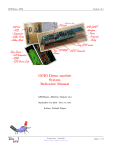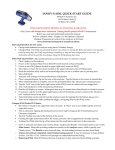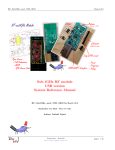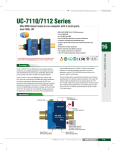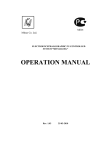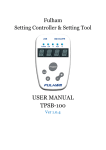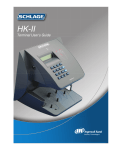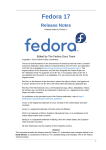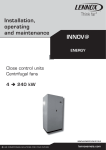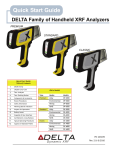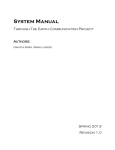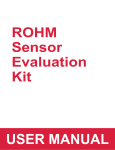Download LPC1224 break-out board System Reference Manual - Techno
Transcript
LPC1224_BO_SRM Board v0.3 LPC1224 break-out board System Reference Manual LPC1224_BO_SRM for Board v0.3 September 10, 2015 - Doc rev 0.3b Author: Nathaël Pajani Techno-Innov - DomoTab http://www.techno-innov.fr page 1 / 22 LPC1224_BO_SRM Board v0.3 Table des matières 1 Introduction 4 2 Licenses 2.1 Documentation . . . . . . . . . . . . . . . . . . . . . . . . . . . . . . . . . . . . . . . . . . . . . . . . 2.2 Hardware . . . . . . . . . . . . . . . . . . . . . . . . . . . . . . . . . . . . . . . . . . . . . . . . . . . 2.3 Software . . . . . . . . . . . . . . . . . . . . . . . . . . . . . . . . . . . . . . . . . . . . . . . . . . . . 4 4 4 4 3 Hardware 3.1 Dimensions . . . . . . . . . . 3.2 Connectors . . . . . . . . . . 3.2.1 P1 Connector . . . . . 3.2.2 P2 Connector . . . . . 3.2.3 P6 and P7 Connectors 3.3 Jumpers . . . . . . . . . . . . 3.3.1 J3 and J4 jumpers . . . . . . . . . 5 5 5 6 7 7 8 8 . . . . . . . . . . 9 9 10 10 10 10 10 11 11 11 12 . . . . . . . . . . . 13 13 13 13 14 14 14 15 15 15 15 15 . . . . . . . . . . . . . . 4 Electronics 4.1 Micro-controller LPC1224 . . . . 4.1.1 Internal RAM . . . . . . . 4.1.2 Internal Flash . . . . . . . 4.1.3 Communication interfaces 4.1.4 GPIO . . . . . . . . . . . 4.1.5 ADC . . . . . . . . . . . . 4.1.6 Reset and ISP mode . . . 4.2 I2C . . . . . . . . . . . . . . . . . 4.3 User Led and Button . . . . . . . 4.4 USB to UART bridge . . . . . . . . . . . . . . . . . . . . . . . . . . . . . . . . . . . . . . . . . . . . . . . . . . . . . . . . . . . . . . . . . . . . . . . . . . . . . . . . . . . . . . . . . . . 5 Software 5.1 Sample Source Code . . . . . . . . . . . . 5.1.1 Grab the sources . . . . . . . . . . 5.1.2 Sample code content . . . . . . . . 5.1.3 Sample code entry point . . . . . . 5.2 Building the binary . . . . . . . . . . . . . 5.2.1 Get a toolchain . . . . . . . . . . . 5.2.2 Build command and options . . . . 5.2.3 Build process . . . . . . . . . . . . 5.3 Uploading binary on target . . . . . . . . 5.3.1 Tools . . . . . . . . . . . . . . . . 5.3.2 Connection with target and upload . . . . . . . . . . . . . . . . . . . . . . . . . . . . . . . . . . . . . . . . . . . . . . . . . . . . . . . . . . . . . . . . . . . . . . . . . . . . . . . . . . . . . . . . . . . . . . . . . . . . . . . . . . . . . . . . . . . . . . . . . . . . . . . . . . . . . . . . . . . . . . . . . . . . . . . . . . . . . . . . . . . . . . . . . . . . . . . . . . . . . . . . . . . . . . . . . . . . . . . . . . . . . . . . . . . . . . . . . . . . . . . . . . . . . . . . . . . . . . . . . . . . . . . . . . . . . . . . . . . . . . . . . . . . . . . . . . . . . . . . . . . . . . . . . . . . . . . . . . . . . . . . . . . . . . . . . . . . . . . . . . . . . . . . . . . . . . . . . . . . . . . . . . . . . . . . . . . . . . . . . . . . . . . . . . . . . . . . . . . . . . . . . . . . . . . . . . . . . . . . . . . . . . . . . . . . . . . . . . . . . . . . . . . . . . . . . . . . . . . . . . . . . . . . . . . . . . . . . . . . . . . . . . . . . . . . . . . . . . . . . . . . . . . . . . . . . . . . . . . . . . . . . . . . . . . . . . . . . . . . . . . . . . . . . . . . . . . . . . . . . . . . . . . . . . . . . . . . . . . . . . . . . . . . . . . . . . . . . . . . . . . . . . . . . . . . . . . . . . . . . . . . . . . . . . . . . . . . . . . . . . . . . . . . . . . . . . . . . . . . . . . . . . . . . . . . . . . . . . . . . . . . . . . . . . . . . . . . . . . . . . . . . . . . . . . . . . . . . . . . . . . . . . . . . . . . . . . . . . . . . . . . . . . . . . . . . . . . . . . . . . . . . . . . . . . . . . . . . . . . . . . . . . . . . . . . . . . . . . . . . . . . . . . . . . . . . . . . . . . . . . . . . . . . . . . . . . . . . . . . . . . . . . . . . . . . . . . . . . . . . . . . . . . . . . . . . . . . . . . . . . . . . . . . . . . . . . . . . . . . . . . . . . . . . . . . . . . . 6 Board revisions history 16 6.1 v01 . . . . . . . . . . . . . . . . . . . . . . . . . . . . . . . . . . . . . . . . . . . . . . . . . . . . . . . 16 6.2 v02 . . . . . . . . . . . . . . . . . . . . . . . . . . . . . . . . . . . . . . . . . . . . . . . . . . . . . . . 16 6.3 v03 . . . . . . . . . . . . . . . . . . . . . . . . . . . . . . . . . . . . . . . . . . . . . . . . . . . . . . . 16 7 Annexes 17 Techno-Innov - DomoTab http://www.techno-innov.fr page 2 / 22 LPC1224_BO_SRM 7.1 7.2 7.3 7.4 Schematics . . . . . . . . . BOM . . . . . . . . . . . . . 7.2.1 Block version . . . . 7.2.2 Easy order version . Document revision History . Disclaimer . . . . . . . . . . Board v0.3 . . . . . . . . . . . . . . . . . . . . . . . . . . . . . . . . . . . . . . . . . . . . . . . . . . . . . . . . . . . . . . . . . . . . . . . . . . . . . . . . . . . . . . . . . . . . . . . . . . . . . . . . . . . . . . . . . . . . . . . . Techno-Innov - DomoTab http://www.techno-innov.fr . . . . . . . . . . . . . . . . . . . . . . . . . . . . . . . . . . . . . . . . . . . . . . . . . . . . . . . . . . . . . . . . . . . . . . . . . . . . . . . . . . . . . . . . . . . . . . . . . . . . . . . . . . . . . . . . . . . . . . . . . . . . . . 17 21 21 22 22 22 page 3 / 22 LPC1224_BO_SRM 1 Board v0.3 Introduction You are reading the System Reference Manual for the LPC1224 break-out board. This manual covers the board use and design. The LPC1224 break-out board is an electronics development and prototyping platform using the LPC1224 microcontroller from NXP 1 . The LPC1224 micro-controller has a Cortex-M0 ARM core, a minimum of 32KB of flash memory, 4KB of internal SRAM, and multiple interfaces. The board also includes a bi-color user LED (Red / Green), a reset button, an ISP mode select / User button, an USB-to-UART bridge (used for programming and easy communication with the module), and 34 GPIO available on 2.54mm pins dispatched for easy use on prototyping boards. Binaries for the LPC1224 break-out board can be generated using a gcc ARM toolchain and uploaded using the serial line (over USB thanks to the integrated USB-to-UART bridge) and our lpcprog tool (or similar tools). The LPC1224 break-out board is designed for users interested in embedded ARM micro-controller development using free, libre and open source softwares only. Every information about the design is available and all documentations are freely accessible. You can download the source files for the LPC1224 break-out board and modify them using KiCad EDA (GPL) according to the license terms found in the license section. You can create your own LPC1224 break-out board or a modified version. In this document the LPC1224 break-out board will be referred as the board. 2 Licenses 2.1 Documentation The present document is under Creative Commons CC BY-SA 3.0 License. It is written in LATEX and the PDF version is generated using pdflatex. 2.2 Hardware The LPC1224 break-out board hardware and schematics are under Creative Commons CC BY-SA 3.0 License. You can produce your own original or modified version of the LPC1224 break-out board, and use it however you like, even sell it for profit. 2.3 Software All the software examples created for the LPC1224 break-out board are under GPLv3 License. The lpcprog tool used to program the module is also under GPLv3 License. 1. http://www.nxp.com/products/microcontrollers/cortex_m0_m0/LPC1224FBD48.html Techno-Innov - DomoTab http://www.techno-innov.fr page 4 / 22 LPC1224_BO_SRM 3 Board v0.3 Hardware 3.1 Dimensions Fig 1 – USB A board type Fig 2 – micro USB board type Fig 3 – Headers (2.54mm) Figures 1, 2 and 3 give the different dimensions and the position of the main elements (connectors, buttons and user led) of the module. The only difference between the "USB A" and the "micro USB board types is the USB connector. Note : Not all components are connector are the same on both b 3.2 Connectors The module has two 2.54mm pitch headers numbered P1 and P2, and one USB connector, either P6 or P7 depending on the board type. Refer to figure 4 for connectors position and to table 1 for a short description. Detailed description of the signals found on each connector pin follow. Name P1 P2 P6 P7 Description 19 pins, 2.54mm pitch header. Provides +3.3V, ground, UARTS, I2C, SPI, and GPIO from port 0. 19 pins, 2.54mm pitch header. Provides +5V from USB, ADC, and GPIO from port 0 and 1. USB micro-AB female connector. Available only on micro USB board type. USB A male connector. Available only on USB A board type. Table 1 – Module Connectors Description Techno-Innov - DomoTab http://www.techno-innov.fr page 5 / 22 LPC1224_BO_SRM Board v0.3 Fig 4 – Module Connectors 3.2.1 P1 Connector Fig 5 – P1 Connector Pin # 1 2 3 4 5 6 7 8 9 10 11 12 13 14 15 16 17 18 19 Description +3.3V : +3.3 Volt Rx0 : LPC UART_0 Receive Data Tx0 : LPC UART_0 Transmit Data Rx1 : LPC UART_1 Receive Data Tx1 : LPC UART_1 Transmit Data SCL : Clock for I2C bus SDA : Bidirectional Serial Data for I2C bus SCK : Clock for SPI bus SSEL : Slave Select for SPI bus MISO : Master In Slave Out for SPI bus MOSI : Master Out Slave In for SPI bus GND : Ground GND : Ground LPC LPC LPC LPC LPC LPC LPC LPC LPC LPC LPC LPC LPC LPC LPC LPC LPC - Pin pin pin pin pin pin pin pin pin pin pin pin pin pin pin pin pin 15 16 17 18 19 20 21 22 23 24 25 26 29 30 31 32 : : : : : : : : : : : : : : : : PIO0_0 PIO0_1 PIO0_2 PIO0_3 PIO0_4 PIO0_5 PIO0_6 PIO0_7 PIO0_8 PIO0_9 PIO0_10 PIO0_11 PIO0_14 PIO0_15 PIO0_16 PIO0_17 Table 2 – P1 Connector Pinout P1 connector is a standard 2.54mm (0.1 inch) pitch header, with 1 row of 19 pins, and can be populated using either male or female header, and mounted either on top or on bottom of the board. P1 connector provides access to +3.3V, Ground, UART0, UART1, I2C, SPI, and additional GPIO pins from port 0 of the LPC micro-controller. Techno-Innov - DomoTab http://www.techno-innov.fr page 6 / 22 LPC1224_BO_SRM 3.2.2 Board v0.3 P2 Connector P2 connector is a standard 2.54mm (0.1 inch) pitch header, with 1 row of 10 pins, and can be populated using either male or female header, and mounted either on top or on bottom side of the board. P2 connector provides access to USB +5V power supply, ADC, and GPIO pins from port 0 and 1 of the LPC micro-controller. Fig 6 – P2 Connector Pin # 1 2 3 4 5 6 7 8 9 10 11 12 13 14 15 16 17 18 19 Description +5V : +5 Volt from USB connector ADC5 ADC4 ADC3 ADC2 ADC1 ADC0 LPC LPC LPC LPC LPC LPC LPC LPC LPC LPC LPC LPC LPC LPC LPC LPC LPC LPC LPC Pin pin pin pin pin pin pin pin pin pin pin pin pin pin pin pin pin pin pin 14 : PIO0_29 13 : PIO0_28 12 : PIO0_27 11 : PIO0_26 10 : PIO0_25 9 : PIO0_24 8 : PIO0_23 7 : PIO0_22 6 : PIO0_21 5 : PIO0_20 4 : PIO0_19 33 : PIO0_18 39 : PIO1_3 38 : PIO1_2 37 : PIO1_1 36 : PIO1_0 35 : PIO0_31 34 : PIO0_30 Table 3 – P2 Connector Pinout Note : Most P2 pins also provide alternate capture or match input functions for 32-bit timers. Refer to the LPC1224 documentation from NXP for full documentation of the alternate functions. Note : When the board is not connected to a power source on the USB port the +5V is not present on pin 1 of P2 connector. 3.2.3 P6 and P7 Connectors P6 and P7 are one-time choice options. Only one of them is present, depending on the board type. Both are standard USB connectors. P6 is a female micro-AB port, and P7 is a male USB-A port. Refer to the Universal Serial Bus (USB) 2 page on Wikipedia for pinout and more information on the USB bus and connectors. 2. http://fr.wikipedia.org/wiki/Universal_Serial_Bus Techno-Innov - DomoTab http://www.techno-innov.fr page 7 / 22 LPC1224_BO_SRM Board v0.3 Fig 7 – P6 and P7 Connectors 3.3 Jumpers The module has 2 configuration jumpers, numbered J3 and J4. Jumpers are common to all board types. Fig 8 – Module Jumpers Name J3 and J4 Description Selection between UART0 andUART1 for USB-to-UART bridge. Table 4 – Module Jumpers Description 3.3.1 J3 and J4 jumpers J3 and J4 jumpers are used to connect UART0 or UART1 pins to the FTDI FT230XS USB-to-UART bridge. When the jumpers are on the top two pins for each jumper, then UART0 is connected to the USB-to-UART bridge. This position must be used for binary upload in ISP mode. When the jumpers are on the bottom pins for each jumper, then UART1 is connected to the USB-to-UART bridge. It is possible to operate the board without jumpers. Then the UAS-to-UART is not connected to the microcontroller. Note : It is not mandatory for the jumpers to be on the same position on J3 and J4. Techno-Innov - DomoTab http://www.techno-innov.fr page 8 / 22 LPC1224_BO_SRM 4 Board v0.3 Electronics The LPC1224 break-out board has been created using KiCad 3 EDA software suite for the creation of the schematics and printed circuit boards. See page 19 in the annexes for the full schematics. The sources for the schematics are available for download from the module page 4 on Techno-Innov.fr. Fig 9 – Module Main Components Name U1 U2 U5 D1 D3 D4 Reset ISP Description LPC1224 ARM Cortex-M0 micro-controller. 3.0V LDO reference voltage generator. FTDI FT230XS USB to UART bridge. User led, bicolore (red / green). Green led : FTDI Rx activity. Orange led : FTDI Tx activity.. Reset button for LPC1224 (SW2). ISP mode select button for LPC1224 (SW1). Table 5 – Module Main Components Description 4.1 Micro-controller LPC1224 The module’s micro-controller is a LPC1224 from NXP 5 . The LPC1224 version used on the module is the LPC1224FBD48/101. All LPC1224 have an ARM Cortex-M0 core running at up to 45 MHz. The module uses the internal 12 MHz RC Oscillator as main clock. Its 1% accuracy is suitable for most applications. 3. http://www.kicad-pcb.org/display/KICAD/ 4. http://www.techno-innov.fr/technique-lpc1224-bo/ 5. http://www.nxp.com/products/microcontrollers/cortex_m0_m0/LPC1224FBD48.html Techno-Innov - DomoTab http://www.techno-innov.fr page 9 / 22 LPC1224_BO_SRM Board v0.3 Note : Refer to the LPC1224 documentation from NXP for full list and documentation of the LPC1224 features. Here are only the descriptions of the features used on the module. 4.1.1 Internal RAM The LPC1224FBD48/101 has 4kB of internal SRAM mapped in one block at address 0x1000 0000. 4.1.2 Internal Flash The LPC1224FBD48/101 has 32kB of internal FLASH memory, mapped at address 0x0000 0000. The flash memory programming requires no additional hardware thanks to the In-System Programming (ISP) and In-Application Programming (IAP) on-chip bootloader software. See section 4.1.6 (Reset and ISP mode) or sections 5.2 (Code Compilation) and 5.3 (Uploading binary on target) for more information on internal FLASH memory. 4.1.3 Communication interfaces The module makes use of the following communication interfaces found on the LPC1224 : • Two UARTs : UART0 and UART1 are connected to P1 header and to the USB to UART bridge through J3 and J4 jumpers. UART0 is used for In-System Programming of the LPC1224. • One I2C bus interface supporting full I2C-bus specification and Fast-mode Plus with a data rate of 1 Mbit/s. I2C is connected to P1 header. See section 4.2 for more information. • One SSP/SPI controller with FIFO and multi-protocol capabilities. The SPI bus is also connected to P1 header. 4.1.4 GPIO The module gives access to 34 GPIO pins dispatched on P1 and P2 connectors. Refer to tables 2 and 3 for details of the signals available on these GPIO and to the LPC1224 documentation from NXP for full list of features for each GPIO. 4.1.5 ADC The last six GPIO pins on P2 connector are inputs channels 0 to 5 for the 10-bit ADC of the LPC1224 microcontroller. The internal ADC uses the voltage on the Vref pin as reference voltage for the conversion. The LPC1224 break-out board integrates a 3.0V reference voltage LDO to provide a stable and accurate Vref to the LPC1224. Techno-Innov - DomoTab http://www.techno-innov.fr page 10 / 22 LPC1224_BO_SRM Board v0.3 Fig 10 – ADC Input Pins and Vref 4.1.6 Reset and ISP mode Reseting the LPC1224 without removing the power can be done with the Reset button (SW2). To enter In-System Programming (ISP) mode after reset you must hold the ISP button (SW1) when you release the reset button. The LPC1224 bootloader considers a LOW level on the PIO0_12 pin as an external hardware request to enter ISP mode and start the ISP command handler. The sampling of the GPIO0_12 pin may take up to 3ms. Refer to section 5.3 or to the LPC1224 user manual for more information on ISP mode. If the ISP button is not held when th Reset button is released (and a valid user code is found in Flash memory) then the execution is transfered to the user program. 4.2 I2C The LPC1224 break-out board has no components on the I2C bus, leaving the whole address space available for the user. The LPC1224 break-out board provides two 1.5kOhms pull-up resistors on both SDA and SCL lines. 4.3 User Led and Button The module has three leds and two buttons. The two leds connected to the USB to UART bridge (D3 and D4) and the Reset button have dedicated functions and cannot be assigned other functions. The remaining led (D1) and button (ISP) can be used as the user wishes. The D1 led is a bi-color red / green led connected to PIO1_4 (pin 40) and PIO1_5 (pin 41). Both can be turned on at the same time, providing a third color (orange). Techno-Innov - DomoTab http://www.techno-innov.fr page 11 / 22 LPC1224_BO_SRM Board v0.3 Fig 11 – User Led Note : The PIO1_4 and PIO1_5 pins are not PWM capable so it’s not possible to create shades between red and green without using a lot of processing power. After reset the ISP button can be used by the user to any purpose. It’s state can be read on pin PIO0_12 (pin 27). 4.4 USB to UART bridge Fig 12 – USB to UART bridge In order to ease the development process and the use of the module we added a USB to UART bridge on-board. This bridge is made by a FTDI FT230XS chip. It provides a 3.3V regulated voltage for the module and is well supported on most operating systems so there is usually no configuration required to use it as a serial line on the host development system, removing the need of any additional power source or of specific hardware to program the LPC1224 micro-controller and communicate with the module. The FTDI chip controls two "activity" leds for Rx (D3, the green one) and Tx (D4, orange one) data over the serial link. Removing jumpers J3 and J4 disconnects the USB to UART bridge from the LPC1224 micro-controller. Techno-Innov - DomoTab http://www.techno-innov.fr page 12 / 22 LPC1224_BO_SRM 5 Board v0.3 Software The LPC micro-controller family uses ARM cores, which make them very easy to use. Apart from a few wrappers, all the code can be written in C and compiled using gcc. ARM, NXP and other vendors provide sample code, but published under many different licences. The code we provide for the LPC1224 break-out board is published under the well known GPLv3 licence. 5.1 5.1.1 Sample Source Code Grab the sources An example application code can be downloaded from our git repository 6 using the following clone command : user@host:˜/sw$ git clone http://gitclone.techno-innov.fr/modules The LPC1224 break-out board can use the code from the apps/base sub-directory as there are very few differences between the LPC1224 break-out board and the GPIO Demo module. The only differences are the lack of EEPROM memory and temperature sensor on the I2C bus and the SPI CS pin which is not used for I2C clock activation for the EEPROM and thus fully available to the user. 5.1.2 Sample code content This code provides the micro-controller definitions (Cortex-M0 specific definitions, registers, interrupts ...) and the routines required to start the micro-controller (bootstrap, vector table, power state, flash, clocks). At the time of writing it also provides a basic set of library functions and the drivers for the interfaces found on the module. The list of supported features and interfaces is updated as the development goes on, so read the README file for the full list of supported features and interfaces. The code has been split in five parts : core/ , drivers/ , extdrv/ , apps/ and lib/ (with the associated directories under include/ for the headers) : • core : Contains all the required parts and system initialisations. Many functions in there are defined as weak aliases of dummy functions, so the code compiles even if no drivers are used. When these functions are redefined in the driver code they override the weak definition. • lib : Contains the implemented parts of the small C library for our code. The micro-controller does not run a full Linux system, so the gnu libc must not be used, and even a µClibc is much more than what’s required. Most of the code in these files come from the kernel implementations of libc parts. • drivers : Contains the drivers for the different interfaces found on the module. • extdrv : Provides drivers for external components, either on the module (EEPROM, status led, tmp101 temperature sensor), or to be purshased separately and connected to the module. The number of external parts supported will grow with time. Note that it may not be possible to use all of them at the same time. • apps : Provides sample applications for the different modules made by Techno-Innov which demonstrate either LPC1224 interfaces or external drivers, which can be used as base for your own developments. Most modules will have their own directory under apps/ . The LPC1224 break-out board uses the base/ 6. http://git.techno-innov.fr/?p=modules;a=summary Techno-Innov - DomoTab http://www.techno-innov.fr page 13 / 22 LPC1224_BO_SRM Board v0.3 subdirectory, which is common with the GPIO Demo module. Creating a new app is as easy as creating a new sub-directory under apps/base (with no spaces or special caracters in the name), copying the Makefile from one of the other apps in your new app directory, and creating your own C source file(s) (maybe starting with a copy of an existing example). If you created a new module, you should consider creating a new "module" directory under apps/ with it’s own sub-directories for specific apps. 5.1.3 Sample code entry point The main loop is in main.c in function main() , as with any C program, though main() is called by the bootstrap code ( Reset_Handler() in core/bootstrap.c ) and could have any name. The calls to the system initialisation routines have been put together in the system_init() function. SELECTED_FREQ must be set to one of the FREQ_SEL_**MHz defined in include/core/system.h : • FREQ_SEL_12MHz • FREQ_SEL_24MHz • FREQ_SEL_36MHz • FREQ_SEL_48MHz • FREQ_SEL_60MHz Note : The frequency can go up to 60MHz despite what is said in the documentation, but the microcontroller needs much more power at higher frequencies. Note : system.h provides two sleep functions ( msleep() and usleep() ). These will activate the systick with a 1ms tick if it has not been done yet. Note : usleep() ma The pins used by your application should be configured using either the set_pins() function and pio_config structures (see common_pins[] in most examples) or the config_gpio() function for each used pin. 5.2 5.2.1 Building the binary Get a toolchain Build has been tested using gcc, and only gcc, in the version provided by the Debian project 7 , but any ARM gcc toolchain should do. In order to get the Debian ARM gcc cross-toolchain you must install package gcc-arm-none-eabi . There’s no need for the related libc package here, the libc does not fit in our micro-controller memory. Instead have a look at the content of the lib/ directory, and add stuff there. Alternatively you can download pre-compiled gcc toolchains (many different projects provide their own), or build your own one using crosstool-ng 8 or similar projects. For more information on what is a (cross-)toolchain, have a look at this information page on elinux.org 9 . 7. http://www.debian.org/ 8. http://crosstool-ng.org/ 9. http://elinux.org/Toolchains Techno-Innov - DomoTab http://www.techno-innov.fr page 14 / 22 LPC1224_BO_SRM 5.2.2 Board v0.3 Build command and options Once done with the toolchain installation (or if you already have one) you should build using the provided Makefile by running the simple " make " command from any of the apps/base/ sub-directory. You can also build all apps by running " make " from repository root directory or " make base/my_app " to compile " my_app " from the apps/base/ sub-directory only. ( base may be replaced by any other module name). NoteYou may want to change the CROSS_COMPILE variable from the main Makefile (in the repository root directory) and set it to the prefix of your toolchain. 5.2.3 Build process The specific information about the target (LPC1224 micro-controller) memory (Flash and RAM) used by the linker is in the lpc_link_lpc1224.ld linker script. The vector table is defined in the core/bootstrap.c file, but the checksum of the first seven entries in the vector table is left unmodified. This checksum must be computed and placed in the eighth vector entry as the bootloader needs to find a valid checksum in the eighth entry to consider the user code as valid and transfer execution to the reset handler (first vector table entry). This is done by the lpcprog tool before sending the binary to the target. 5.3 5.3.1 Uploading binary on target Tools To flash the binary (the one with .bin) to the LPC Flash you can use our lpctools package, packaged for Debian as of 2014-09-10 and available in jessie or newer versions, or available in the lpctools git repository 10 . Lpctools is released under GPLv3 licence. Clone the repository using : user@host:˜/sw$ git clone http://gitclone.techno-innov.fr/lpctools Then build ( make ) the tools. Note : Other tools may be used but have not been tested. No tools were found to be open source when we looked for tools to upload the binaries to the micro-controller. You must check that the tool you chose to use can take care of the checksum computation. 5.3.2 Connection with target and upload Usual command line to upload a binary to the micro-controller : 10. http://git.techno-innov.fr/lpctools Techno-Innov - DomoTab http://www.techno-innov.fr page 15 / 22 LPC1224_BO_SRM Board v0.3 user@host:˜/sw$ lpcprog -d /dev/ttyUSB0 -c flash mod_gpio.bin Part ID 0x3640c02b found on line 18 Flash now all blank. Checksum check OK Flash size : 32768, trying to flash 8 blocks of 1024 bytes : 8192 Writing started, 8 blocks of 1024 bytes ... user@host:˜/sw$ If you want to get information on the connected device use the id command of lpcprog : user@host:˜/sw$ lpcprog -d /dev/ttyUSB0 -c id Part ID 0x3640c02b found on line 18 Part ID is 0x3640c02b UID: 0x1228f5f5 - 0x4b324307 - 0x08333834 - 0x4d7b2c1a Boot code version is 1.6 user@host:˜/sw$ Note : The part information definition for each supported micro-controller is in the lpctools package. See lpctools readme and lpcprog or lpcisp help (-h option) or manpages for more information. 6 6.1 Board revisions history v01 This board revision has not been sold. First prototype version, with Rx and Tx crossed for UART1, making it impossible to connect them to USB to UART bridge. 6.2 v02 This board revision has not been sold. Added 3.0V LDO voltage regulator for Vref. 6.3 v03 Actual version sold as of writting of this documentation. Added a 100nF cap to Vref pin. Techno-Innov - DomoTab http://www.techno-innov.fr page 16 / 22 LPC1224_BO_SRM 7 Board v0.3 Annexes 7.1 Schematics The board schematics and PCB layout have been created using KiCad 11 EDA software suite. You can download the sources on the module page 12 on Techno-Innov.fr. (See on next pages) 11. http://www.kicad-pcb.org/display/KICAD/ 12. http://www.techno-innov.fr/technique-lpc1224-bo/ Techno-Innov - DomoTab http://www.techno-innov.fr page 17 / 22 C B DGND 0603 P7 GND ID D+ D- 1 2 3 4 1 2 3 4 5 MUSB +V 1 USB Type A male P6 microUSB type AB female 1 Mire R12 1.5k 0603 R13 1.5k DGND 2 UART RX UART_TX M1 0 DGND 10uF C5 100nF C6 0603 20 21 22 23 24 GPIO0_5 GPIO0_6 GPIO0_7 GPIO0_8 GPIO0_9 DGND 100nF C9 11 9 8 2 1 33 32 31 30 29 28 27 26 Reset USBDM USBDP U5 GPIO0_18 19 GPIO0_4 25 18 17 16 15 DGND 10uF C1 0.1uF C3 DGND TxD RxD RTS CTS SSOP-16 FT230XS Sleep TxDEN RxLED TxLED LQFP48 XTALOUT XTALIN PIO0_18/SWCLK PIO0_17/MOSI PIO0_16/MISO PIO0_15/SSEL PIO0_14/SCK RESET/PIO0_13 PIO0_12/CLKOUT PIO0_11/SDA PIO0_10/SCL PIO0_9/TXD1 PIO0_8/RXD1 PIO0_7/CTS0 PIO0_6/RIO PIO0_5/DCD0 PIO0_4/DSR0 PIO0_3/DTR0 PIO0_2/TXD0 PIO0_1/RXD0 +5V 2 U1 PIO0_0/RTS0 0.1uF C2 Découplage GPIO0_3 GPIO0_0 Mire MIRE_RONDE SPI_SCLK SPI_CS SPI_MISO SPI_MOSI USB_DM USB_DP Ferrite Bead FB1 Mire +3,3V M2 0 MIRE_RONDE 0603 I2C SCL I2C SDA Programmation USB_5V Reset and ISP mode selection SW2 Reset ISP SW1 +3,3V R2 100k M0 0603 A 0603 0 0603 R1 100k USB 0402 +3,3V 44 MIRE_RONDE 0402 0402 GND 5 47 VDD_IO VSS_IO 16 15 14 7 1 4 2 6 +3,3V DGND 48 0402 10 3V3Out 12 3 VCC VCCIO GND 13 45 46 42 41 40 39 38 37 36 35 34 14 13 12 11 10 Green 1 D3 LED 0603 GPIO0_8 Orange 2 1 D4 LED 0603 2 270 270 JP3X1 2mm JP3X1 AD5 0603 R10 0603 +3,3V GPIO0_9 R11 J4 R3 R4 3 UART_TX UART RX 1k 0603 1k DGND Red Bicolor LED A1 K D1 1 2 3 4 5 6 7 8 9 10 11 12 13 14 15 16 17 18 19 4 Licence : Creative Commons - CC - By - SA Techno-Innov File: LPC1224_Full.sch Sheet: / Title: LPC1224 Breakout Size: A4 Date: 24 may 2014 KiCad E.D.A. DGND GPIO0_9 AD3 AD4 GPIO0_8 AD2 I2C SCL I2C SDA SPI_SCLK SPI_CS SPI_MISO SPI_MOSI GPIO0_6 AD1 SOT-23 A2 GPIO0_5 AD0 Green GPIO0_4 GPIO0_7 GPIO0_3 UART RX UART_TX GPIO0_0 +3,3V GPIO for development GPIO0_29 0603 +3,3V 4 GPIO0_28 GPIO0_27 GPIO0_26 GPIO0_25 GPIO0_24 GPIO0_23 GPIO0_22 GPIO0_21 GPIO0_20 GPIO0_19 2mm UART0/1 Switch LPC1224 LPC1224FBD48/101 RTCXOUT RTCXIN PIO1_6 PIO1_5/AD7 PIO1_4/AD6 PIO1_3/AD5/WAKEUP PIO1_2/SWDIO/AD4 PIO1_1/R/AD3 PIO1_0/R/AD2 PIO0_31/AD1 PIO0_30/AD0 PIO0_29/ROSC PIO0_28 PIO0_27 SWCLK/PIO0_26 9 8 7 6 5 4 IN 1 3 REF3330 DGND Rx and Tx leds Choose two different colors J3 PIO0_24 PIO0_23 PIO0_22 PIO0_21 PIO0_20 PIO0_19 SWDIO/PIO0_25 VREF U2 OUT 0.1uF C4 2 1 2 VDD_3V3 3 VREF_CMP 3 VSS 0402 1 2 43 GND 3 3 2 P1 CONN_19 1 AD0 AD1 AD2 AD3 AD4 AD5 GPIO0_18 GPIO0_19 GPIO0_20 GPIO0_21 GPIO0_22 GPIO0_23 GPIO0_24 GPIO0_25 GPIO0_26 GPIO0_27 GPIO0_28 GPIO0_29 +5V 1 2 3 4 5 6 7 8 9 10 11 12 13 14 15 16 17 18 19 (+5V from USB) 5 5 P2 CONN_19 Rev: 0.3 Id: 1/1 C B A LPC1224_BO_SRM 7.2 7.2.1 Board v0.3 BOM Block version Vendor Vendor ref Farnell ref NXP Multicomp TDK Multicomp Multicomp Multicomp Kingbright Multicomp Texas Instrument LPC1224FBD48/101 MCCA000050 C1608X5R0J106M MC0063W06031%100K MC0063W06031%1K5 MC0063W06031%270R KM-23ESGW DTSM-32S-B 1862465 1758896 2112705 9330402 9330607 9330917 1142614 9471898 REF3330AIDBZT 1755084 2 2 1 1 1 1 1 1 1 2 2 Multicomp Multicomp TDK TDK Vishay Vishay FTDI Molex Multicomp Fisher Harwin MC0063W06031%270R MCCA000050 C1608X5R0J106M MMZ1608R601A VLMG1300-GS08 VLMO1300-GS08 FT230XS 47590-0001 MC32605 SLY1.085.50G M22-1900005 9330917 1758896 2112705 1669700 2251461 2251473 2081321 1568022 1696546 9729135 510932 2 Fischer SL1.025.36Z 9729038 Part Description Ref Module Nb Micro-controller LPC1224 Decoupling capacitors 100nF Filter capacitor 10µF Pull-Up resistors 100k Ohms I2C Pull-Up resistors 1,5k Ohms Bi-color Led resistors 270 Ohms SMD Led Red / Green SMD switchs U1 C2, C3, C4 C1 R1, R2 R12, R13 R3, R4 D1 SW1, SW2 LQFP48 0402 0603 0603 0603 0603 SOT-23 1 3 1 2 2 2 1 2 3.0V Vref U2 SOT-23 1 R10, R11 C6, C9 C5 FB1 D3 D4 U5 P6 P7 J3, J4 0603 0402 0603 0603 0603 0603 16SSOP SMD SMD 2mm P1, P2 2,54mm USB Bridge Led resistors 270 Ohms Decoupling capacitors 100nF Filter capacitor 10µF SMD chip bead Rx Led - Green Tx Led - Orange FT230XS USB to UART Micro-USB type A-B female USB Type A male Male headers 1x3 Jumpers 2mm black GPIO Connectors Male headers GPIO (2 x 19 pins) Table 6 – BOM by functional block Note : Components used on Board may change for functionnally equivalent references without prior notice Techno-Innov - DomoTab http://www.techno-innov.fr page 21 / 22 LPC1224_BO_SRM 7.2.2 Board v0.3 Easy order version Vendor Vendor ref 1 1 1 NXP FTDI TDK LPC1224FBD48/101 FT230XS MMZ1608R601A Farnell ref 1862465 2081321 1669700 0402 5 Multicomp MCCA000050 1758896 0603 0603 0603 2 2 2 TDK Multicomp Multicomp C1608X5R0J106M 2112705 MC0063W06031%100K 9330402 MC0063W06031%1K5 9330607 0603 4 Multicomp MC0063W06031%270R 9330917 SOT-23 0603 0603 1 1 1 2 1 1 2 2 2 Kingbright Vishay Vishay Multicomp Molex Multicomp Fisher Harwin Fischer KM-23ESGW VLMG1300-GS08 VLMO1300-GS08 DTSM-32S-B 47590-0001 MC32605 SLY1.085.50G M22-1900005 SL1.025.36Z Part Description Ref Module Nb LPC1224 FT230XS USB to UART SMD chip bead U1 U5 FB1 C2, C3, C4, C6, C9 C1, C5 R1, R2 R12, R13 R3, R4, R10, R11 D1 D3 D4 SW1, SW2 P6 P7 J3, J4 LQFP48 16SSOP 0603 P1, P2 2,54mm Decoupling capacitors 100nF Filter capacitor 10µF Pull-Up resistors 100k Ohms I2C Pull-Up resistors 1,5k Ohms Led resistors 270 Ohms SMD Led Red / Green Rx Led - Green Tx Led - Orange SMD switchs Micro-USB type A-B female USB Type A male Male headers 1x3 Jumpers 2mm black Male headers GPIO (2 x 19 pins) SMD SMD 2mm 1142614 2251461 2251473 9471898 1568022 1696546 9729135 510932 9729038 Table 7 – BOM by reference Note : Components used on Board may change for functionnally equivalent references without prior notice 7.3 Document revision History Version Date Author 0.3a April 12, 2015 Nathaël Pajani Initial revision 0.3b September 10, 2015 Nathaël Pajani Changes according to code organisation modifications 7.4 Information Disclaimer The LPC1224 break-out board is provided "as is" without warranty of any kind, either expressed or implied, including, but not limited to, the implied warranties of merchantability and fitness for a particular purpose. The entire risk as to the quality and performance of the LPC1224 break-out board is with you. Should the LPC1224 break-out board prove defective, you assume the cost of all necessary servicing, repair or correction. Techno-Innov - DomoTab http://www.techno-innov.fr page 22 / 22






















